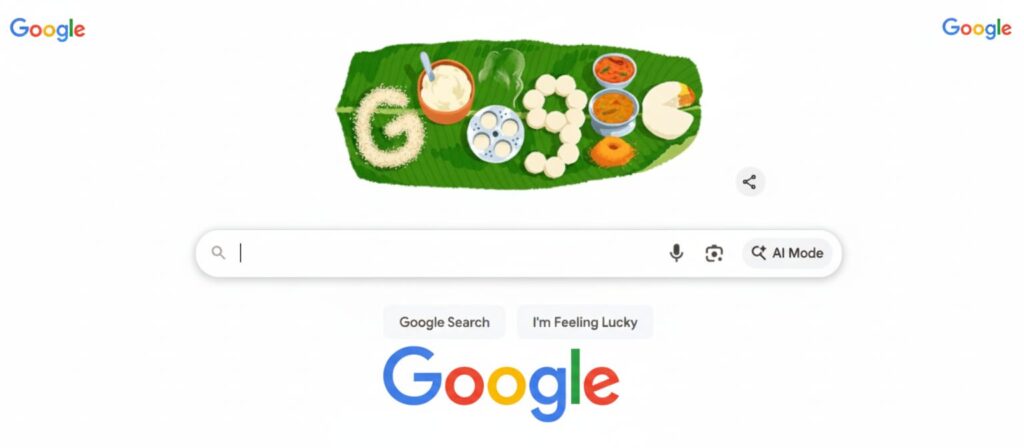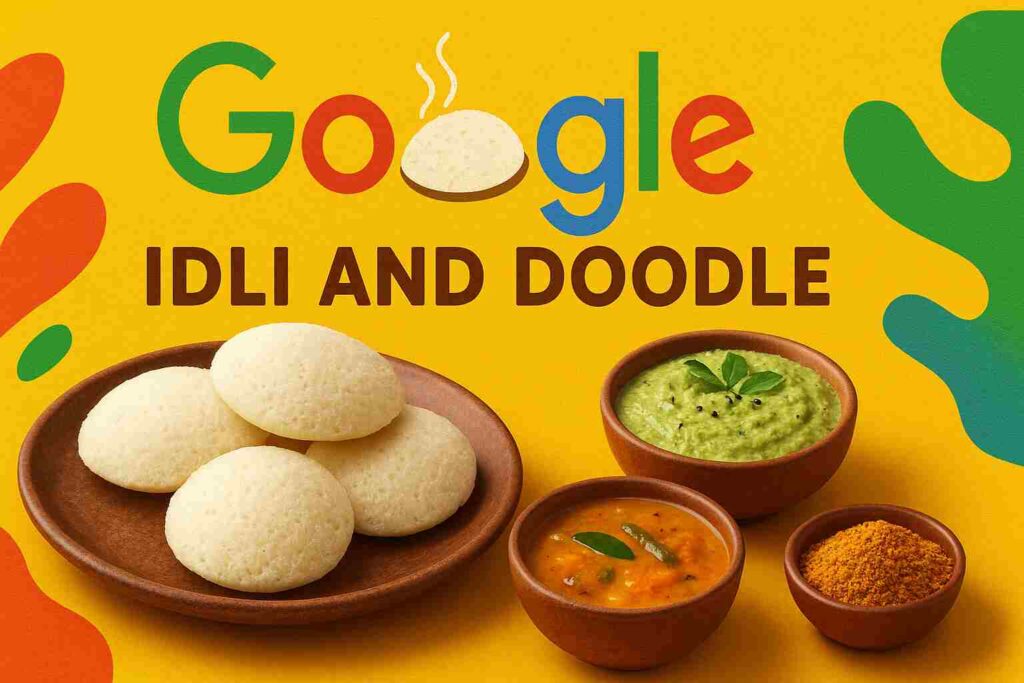Today, Google’s Doodle honors a humble yet glorious South Indian treat — idli. This isn’t just any food celebration. It’s a tribute to the steamed, spongy, fermented rice-and-lentil cake that millions awaken to, savor, and adore. In this article, we will explore what makes the Doodle memorable, dive deep into the magic of idli, share tips and recipes, and celebrate the love that idli lovers carry in their hearts.

Table of Contents
What Is the “Idli and Doodle” Today?
Google often changes its homepage logo — that special art is called a Doodle. Today’s Doodle features idli, placing this South Indian classic front and center for people all over the world to see. (It launched on October 11, 2025)
By featuring idli, Google is sending a message: everyday food traditions matter. And for those who haven’t encountered idli before, this Doodle is a delightful introduction to a culinary marvel.
Why Idli? Why Now?
Idli is more than a breakfast dish — it’s a cultural icon, a health food, and a comfort food all at once. The fact that Google chose to create an Idli and Doodle signals how beloved this dish is, not just in South India, but in many homes, hearts, and kitchens around the world.
Idli is made from a simple batter of rice and urad dal (black gram lentils), fermented and then steamed into soft cakes. Because of fermentation, it becomes light, airy, and easier to digest.
It is naturally vegan, gluten-free, and gentle on the stomach — making it a winner for many tastes and dietary needs.
The Doodle’s appearance also invites people to learn about idli — its origin, how to make it, and why so many of us treasure it.
The Heart of Idli: How It’s Made
For a true idli lover, the journey from raw grains to fluffy cakes is almost magical. Let’s break down the steps in a way that any home cook can follow.
Ingredients You’ll Need
To make about 15–20 idlis, here’s a basic list:
- Rice (ideally “idli rice” or parboiled rice)
- Urad dal (dehusked black gram or split black lentils)
- A pinch of fenugreek seeds (optional, but helps fermentation)
- Water
- Salt
Some people also add a bit of poha (flattened rice) or leftover cooked rice to make the idlis softer, especially in cooler weather.
Step 1: Soaking
Wash the rice and dal separately until the water runs nearly clear. Soak them in water for about 4–6 hours (or overnight in hot climates). If you use fenugreek seeds, soak them with the dal.
Step 2: Grinding
Grind the urad dal into a smooth, light, fluffy batter. Use as little water as needed to reach that fluffy texture. Separately grind the rice (or rice + some broken pieces) to a slightly coarse paste.
Then combine both batters in a large bowl. If you’re adding poha or cooked rice, mix them in now. Use your hand or a clean spoon to fold everything gently — the warmth of your hand helps kickstart fermentation.
Step 3: Fermentation
Cover the batter and leave it in a warm spot for 8–12 hours (sometimes overnight). The batter should rise, become airy, and show tiny bubbles. That’s the sign that the microbes are at work.
If it’s cold, you may place it inside an oven with just the light turned on, or near a warm corner of your kitchen.
Step 4: Adding Salt + Final Mix
Once the batter has fermented, gently stir in salt. Be careful not to knock out all the air — that fluffiness will help your idlis.
Step 5: Steaming
Grease the idli molds or plates. Pour the batter into each cavity (not overfilled). Steam over medium-high heat for 10–12 minutes, or until a toothpick inserted comes out clean.
After steaming, let them rest for 1–2 minutes before gently removing the idlis with a spoon.
Tips for Perfect, Soft Idlis
- Use good quality rice and urad dal
- Don’t over-ferment — too sour batter can give dense idlis
- Ensure the steamer’s water is already boiling before placing the trays
- Use filtered or boiled-cool water if your local water disrupts fermentation
- Don’t overmix after fermentation — handle the batter gently
Variations & Regional Twists
Idli is truly versatile. Over time, many regional and creative versions have emerged:
- Rava idli — made with semolina (rava) instead of rice, a Karnataka favorite. This was invented during a time when rice was scarce. Wikipedia
- Stuffed idli / masala idli — with spiced fillings
- Ragi idli, millet idli — healthier whole grain variations
- Idli pancakes / idli upma — made from leftover idlis
- Sanna — the Konkani/Goan cousin of idli
These versions prove that idli is a canvas — you can adapt, experiment, and still remain connected to its soul.
Accompaniments That Make Idli Sing
No idli experience is complete without:
- Coconut chutney (fresh coconut + green chilies + mild tang)
- Sambar (a lentil and vegetable stew)
- Idli podi / gunpowder with ghee or sesame oil
Together, they create a balance: soft idli + spicy, tangy chutney + hearty sambar = breakfast bliss.
Health Benefits & Why Idli Is Loved
For the idli lover, part of the love is in knowing how good this food is for you:
- Fermentation boosts digestibility and helps break down starches. Wikipedia
- It’s low in fat, naturally vegan, and gluten-free.
- Because it’s steamed, it doesn’t require oil — making it lighter than fried breakfasts.
- Serves as wholesome energy for all ages — children, adults, and elders alike.

Cultural & Emotional Significance
Idli comes with memories. For many, it’s the warm aroma from the kitchen at dawn, the first bite with soft coconut chutney, the comforting feeling of home.
In South India, many families have passed down their secret idli batter tricks (a little extra water, a dash of rice, a timing cue) from one generation to the next.
Even beyond India, in Sri Lanka and among Indian diaspora communities, idli enjoys popularity — a reminder of home, heritage, and simple delight.
The Global Nod: Idli Meets Doodle
By making an Idli and Doodle, Google brings idli into the spotlight — not as a niche regional fare, but as something global. It invites people who’ve never heard of idli to look, click, and maybe try it someday.
For idli lovers, this is a moment of pride. We see our favorite dish celebrated alongside other iconic global symbols. It’s a validation of our tradition, our kitchens, and our everyday joys.
How You Can Join the Celebration
- Cook a special batch of idli today — try one of the variant recipes
- Share a photo of your idli with the hashtag #IdliAndDoodle
- Teach someone how to make idli — pass on the love
- Experiment with creative idli flavors — maybe ragi or millet
- Pair with your favorite chutney and sambar and savor the moment
Summing Up
Today’s Idli and Doodle is more than a cartoon on a homepage. It’s a tribute to a food that’s gentle yet powerful, simple yet rich in culture, healthy yet utterly satisfying.
To all idli lovers reading this: celebrate this moment. Make an extra batch, share your secrets, and let the world know why idli holds a special place in your heart.
After all, food is love, tradition, and joy — especially when it’s an idli.
Disclaimer:
The information presented in this article is for general informational and news purposes only. While efforts are made to ensure accuracy, the publisher assumes no responsibility for any errors or omissions. All trademarks, images, and names mentioned belong to their respective owners.

